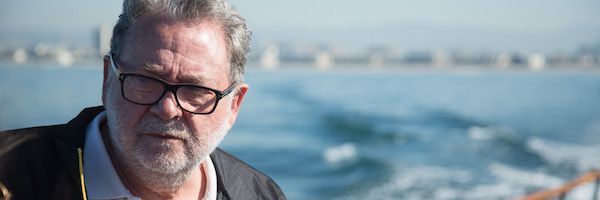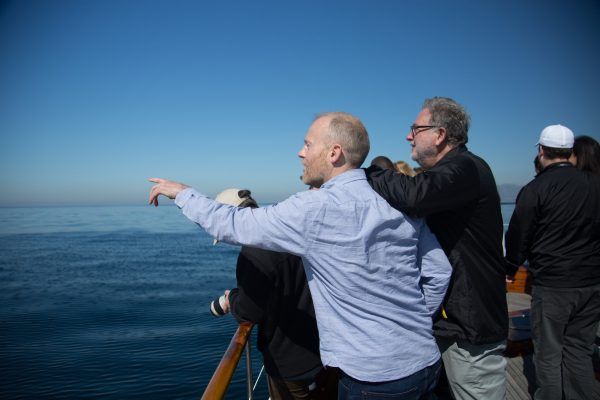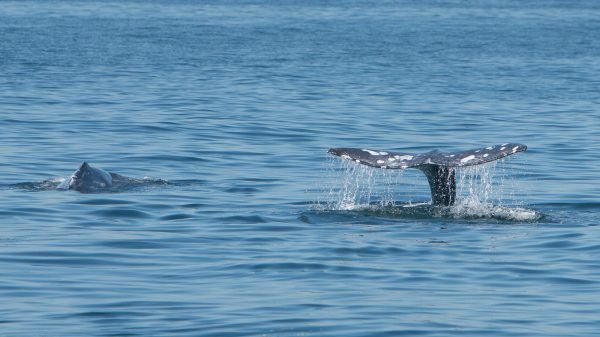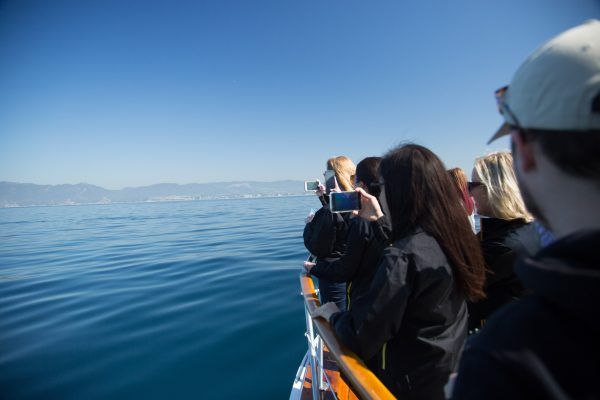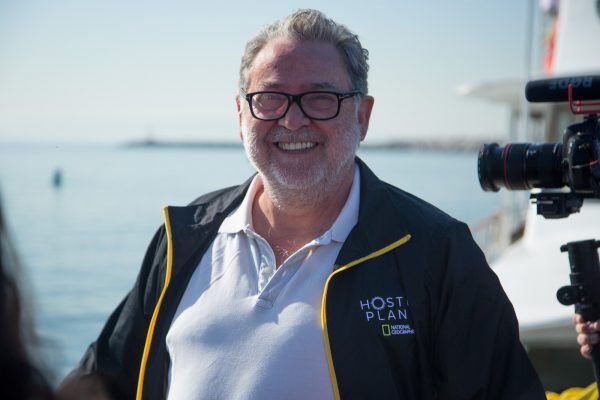A hush has washed over everyone on deck of the Legend. The yacht has slowed and began to rock with the gentle waves just off the coast of Malibu as everyone searches with their eyes over the vast blue ocean, the sun heating up the early March morning. Suddenly, a gasp at the front of the boat by someone on the rail alerts everyone that a gray whale has just come up for air. But it's not just one – a second, then a third whale breaches the surface before all three fluke (dive deeper into the water, causing their tails to lift above the water as they descend).
After three hours of whale watching with National Geographic and the team behind the new nature docu-series Hostile Planet, everyone's spirits are high. The captain and crew onboard the Legend all have big smiles on their faces, and it's clear that this was one of their more successful whale watching expeditions. The weather conditions were perfect the entire time and the whales seemed to be playful, showing off for us instead of swimming away. Over and over, we keep getting told how "lucky" we were to have seen so many whales.
And to hear award-winning filmmaker Guillermo Navarro tell it, luck is the most valuable asset when it comes to capturing underwater miracles on camera. The genius behind Pan's Labyrinth cinematography, for which he won an Oscar, is the executive producer for Hostile Planet, teaming with executive producers Tom Hugh-Jones, Martha Holmes, Delbert Shoopman and host Bear Grylls to shine a light on some of the planet's most extreme environments and how animals have extraordinarily evolved to survive in them.
One episode in particular of the six-part natural history series is all about oceans, with breathtaking footage of blue whales near San Diego, opalescent squid near the Channel Islands and vampire squid, comb jellyfish and barreleye fish near Monterey Bay Canyon. According to Navarro, the most important thing he had to remember when filming underwater footage for the new docu-series is "luck."
"As you saw today, we were lucky to just see a glimpse of the whales, and we saw quite a bit," Navarro tells Collider. "But then to see that in abundance and to have the ability to have a camera here and the camera there and move with them, that's heaven. It's almost impossible to do."
That's not to say that Navarro and the rest of the Hostile Planet team left everything to chance when it came time to film the oceans episode – they did their research and planning for a long time before it was time to head out on the water. But in the end, that's exactly what they had to rely on.
"You can hope for it, you can plan it and you can have your wish list, but until you're there and the circumstances are like water through your hands, you can get nothing," Navarro says. "It's really challenging and it's really a lot of luck involved and a lot of determination in the crew going after it. There's no recipe for doing it. I cannot tell you what to do to repeat it. It's a perfect storm of great circumstance."
Filming a series is stressful enough, but to add in an unpredictable aspect of not knowing if you'll even get a sighting of the whales you've been tracking? That's downright panic-inducing. That's why Navarro and the Hostile Planet team did as much as they could beforehand to make sure they weren't going in blind.
"We've got a great team on the ground and they had the right tools to do it, which is a lot," Navarro says. "And then as you witnessed today, going out on the ocean, it's not enough just to see them. You have to build a visual narrative as well, and be in the right place at the right time."
And just like with our whale watching expedition, Navarro struck gold with Hostile Planet's oceans episode. There's a sequence involving orcas hunting herring that the team actually interfered at the end of it – "Brutal," he says of taking the orcas' food after the whales had toyed with it for so long. "We're definitely the biggest predator out there." – that Navarro still can't believe they got on camera. "That scene is probably my favorite scene in the episode, the orcas and the herring, the predator and how it ends," he says. "It's really a succession of impossible shots. It's really remarkable what the team did, really remarkable."
That feeling of shock and awe never left Navarro during filming. He "always" thought he wasn't going to be able to pull it off.
"It's not enough to have a shot," he says. "A shot in itself, that's something that I was very much trying to get rid of that mentality, it's not enough to have the paparazzi moment. You have to build a sequence; you have to build a story. That moment is important in the storytelling but it's not enough. You have to have a beginning, a middle and an end. We're looking for that."
And one of the big challenges Navarro faced was making sure that viewers wouldn't just feel like an observer while watching the footage. "We want you to be part of the series," he says. The way he and the Hostile Planet team accomplished that was figuring out the right speed to film at and "have the lens right in place to tell the story and to have that emotional connection with what these animals go through."
That led to the biggest lesson that Navarro learned while making Hostile Planet: you can "introduce a visual language."
"It's not necessary to explain everything with voiceover, and we pulled that off," Navarro says. "It's not necessarily just to observe; we want the camera to be there for you to experience it. That was really my role: to bring film language and have the visual storytelling take over for you to be able to experience what it's like to be there."
With an Oscar for cinematography under his belt, Navarro certainly has his expertise in visual storytelling.
"I started my career doing documentaries, and then I went off to do feature work and drama work," he says. "I felt that this opportunity of changing things in the way of doing things would close a full circle of my work. That's what I'm emotionally very charged with and very proud of. I do think that my role had an impact. The same way that I could bring my documentary experience to the feature narrative, now I could bring feature narrative into the documentary experience."
Hostile Planet premieres April 1st at 9 p.m. on National Geographic.

